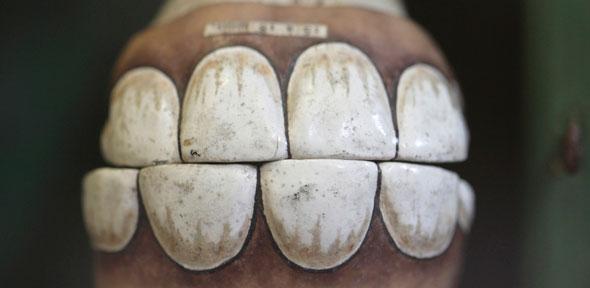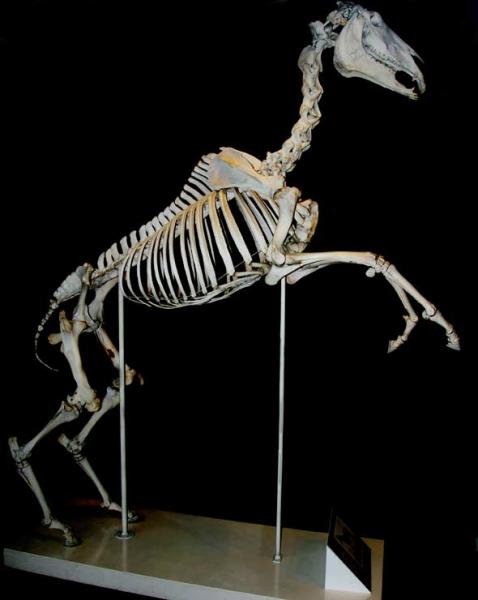Clik here to view.

One hundred and seventy years ago, the French state commissioned a physician called Louis Auzoux to make models of horse’s teeth as examples of healthy and unhealthy equine dentition. At a time when cadavers were in short supply, Auzoux had pioneered a method of making realistic models of human and animal bodies to use as teaching aids.
As horses mature, and then grow older, their teeth change. People familiar with horses can gauge a horse’s age by looking in its mouth. This practice is the origin of the saying, “Don’t look a gift horse in the mouth.” In fact, this was a very good idea if you were buying a horse; in order to make an animal appear younger, and demand a higher price, dishonest dealers sometimes filed down horses’ teeth.
Malformed teeth, which prevent a horse from eating properly and affect its performance, are another problem to look out for – as are signs of ‘vices’ such as crib-biting and wind-sucking.
The Whipple Museum of the History of Science in Cambridge has a set of horse teeth models made by a factory set up by Auzoux. Dated 1890, and still housed in the sturdy case made to transport them, this ‘box set’ of smiling and grimacing equine teeth is one of the best-loved objects in the museum and takes prime position in its twitter feed.
Less than half a mile from the Whipple Museum is the Museum of Classical Archaeology, home to 35 plaster casts of horses, taken from the originals. Cantering, trotting, rearing and frolicking, these horses are the stars of the procession which winds its way around the famous frieze adorning the Parthenon, the showpiece temple atop the Akropolis in Athens.
Image may be NSFW.
Clik here to view.
The Parthenon was erected when Athens was a flourishing city-state. Construction began in 447 BCE and was finally finished in 432. The temple celebrated the city’s patron goddess, Athena. The horses on the frieze were part of a procession honouring her during the Great Panathenaea. A festival which took place every four years, it featured athletic games including wrestling, javelin throwing and chariot racing.
The frieze shows representatives of the city – city elders and officials, soldiers, young men and unmarried maidens, and even resident aliens, known as ‘metics’ – coming together to process from the city walls to the top of the Akropolis and the temple itself. “These human figures represented the city, or polis, in microcosm,” says Dr Susanne Turner, curator of the Museum of Classical Archaeology.
It is the horses, though, which dominate the frieze. Powerful and compact, with manes and tails flowing and small holes in the marble indicating that they originally wore bronze bridles, the horses are well attuned to the easy grace of the athletic youths on their backs and at their sides. Some of the riders wear flowing cloaks which fan out behind them, as if caught by a breeze. Many wear no other clothes.
“Their nudity is a sort of costume in itself,” says Turner. “There’s something inherently Greek about their nakedness. It connotes strength, beauty and idealised youthful masculinity, but it also carries a wider sense of cultural belonging.”
The rhythm of repeated and overlapping diagonals, made by the limbs of horses and riders, leads the eye across what was originally a frieze 160m in length, made up by 115 blocks. On the Parthenon the frieze would have soared 12m above floor level. “Viewers approaching the temple saw first the horses and their riders preparing to join the procession,” says Turner.
“As they turned the corner to walk along the long sides of the temple, so too did the horses, now with riders and chariots. Layered side by side in small groups, they form a cavalcade whose forward motion draws the viewer onwards until they reach the doors of the temple – where the goddess herself was revealed inside, some 10m tall and sculpted from bright white ivory and shining gold.”
Image may be NSFW.
Clik here to view.
Much ancient sculpture was brightly painted and the Parthenon frieze was probably no exception. Surviving evidence for colour is, however, scant. “Ancient colour combinations, where they can be reconstructed, often look harsh and garish to modern eyes. We tend to prefer our classical sculpture white,” says Turner. “The Parthenon horses probably galloped across a bright blue background, their riders’ clothing and hair picked out in primary colours, perhaps with some gold leaf, too.”
The casts were purchased by the Fitzwilliam Museum in 1884, when the Museum of Classical Archaeology was first founded. Produced by a London workshop run by the Brucciani family, the casts are direct copies of the originals, taken from moulds produced by permission of the British Museum. They preserve the three-dimensional presence of the originals in a way which photographs cannot – breathing life into the horses as they high-step joyfully along the length of the frieze as only horses can.
Horses played a central role in the rise of many great civilisations. Archaeological evidence suggests that they were first domesticated during the Neolithic around 5,000 years ago somewhere in the vast grassy pastures of central Asia. “Botai in Kazakhstan has been identified as one of the earliest sites with domestic horses. Botai horses show tooth wear patterns characteristic of the use of harness, and horse milk lipids on pottery fragments show that horse milk was being used,” says Dr Mim Bower, an expert in ancient DNA at the McDonald Institute for Archaeological Research.
“Horse husbandry dispersed from the steppe, westward into Europe, via the grasslands of Eastern Europe or via Iberia, accompanying Bell Beaker cultures, and eastward into China and India. This was concurrent with the spread of chariots and fabulous material culture that comprised the ‘chariot complex’ of the 2nd and 1st millennia BC – for example, the chariot burials at Sintashta and Southern Urals and cylinder seal impressions, depicting horses and chariots, from Kültepe in Turkey.”
The development of pastoral nomadism in central Eurasia between 1000 and 800 BC secured the role of the horse as a source of speed over ground and as an iconic symbol. The archaeological finds associated with this period include exquisitely decorated horse harness and adornments from 4th -3rd century BC sites, such as Pazyryk and Ak-Alakha, Altai and 7th – 4th century BC Arzhan, Tuva.
“Where written records exist for these early periods, for example in China, they highlight the importance of the horse as a symbol of strength and power. Throughout the dynastic eras, horses gained an increasingly important military role. In the Western Zhou period, the raising of horses is recorded as a task that is overseen by kings. In later periods, the military power of the state was measured by the number of horse-chariots,” says Bower.
“These changes are concurrent with, and may have influenced, the intensification of long distance trade routes that connected the far reaches of Eurasia. Tradition states that trade routes, associated with the exchange of silk and spices, between China and Europe, began in the 2nd century BC, instigated by Han Emperor Wu. However, these long distance exchange networks have a deeper past. By 1000 BC, Chinese silk is found in Egypt and by 700 BC in Europe. Horses were almost certainly an integral part of these developments.”
Arab horses were famed for their speed and beauty. It was from the Middle East that three Arab stallions were imported to Britain at the turn of the 18th century. The Darley Arabian, the Godolphin Arabian and the Byerley Turk were crossed with some 70 British mares to produce horses for racing. All British Thoroughbreds trace their lineage back to these world famous ‘foundation stallions’.
Image may be NSFW.
Clik here to view.
The skeleton of a famous British racehorse called Polymelus was given to Cambridge’s Museum of Zoology in the 1930s and until recently stood sentinel in the museum entrance. Polymelus was the sire (father) of a string of leading racehorses foaled (born) between 1914 and 1921. His son Phalaris was a champion racehorse who went on to sire many winners. Among Polymelus’s other descendants are the racehorses Secretariat and Northern Dancer who also became legends in their time.
In a study carried out in 2012, tiny samples of DNA were taken from one of the teeth of the skeleton of Polymelus. They were analysed at the McDonald Institute for Archaeological Research as part of an inter-disciplinary project tracing the genes for speed and stamina found in modern thoroughbreds backwards in time to discover their origins. The DNA of 12 historic horse skeletons was screened, including that of Eclipse, the most famous of all.
The work showed just how rapidly the genetic make-up of a breed can be shaped by humans and will help throw light on common health problems experienced by thoroughbreds. Interestingly, the speed gene which gives horses their sprinting ability was traced back to one of the British mares (including a Shetland pony) used at the early stages of the development of the British Thoroughbred line.
Next in the Cambridge Animal Alphabet: I is for a creature inside which investors, men of science and a notable sculptor dined in style on New Year's Eve 1853.
Inset images: Horses on the Parthenon frieze (Museum of Classical Archaeology); skeleton of Polymelus (Musuem of Zoology).
The Cambridge Animal Alphabet series celebrates Cambridge's connections with animals through literature, art, science and society. Here, H is for Horse – 170-year-old model teeth, the Parthenon friezes, and the surprising origins of racehorses' speed.
Image may be NSFW.
Clik here to view.
The text in this work is licensed under a Creative Commons Attribution 4.0 International License. For image use please see separate credits above.